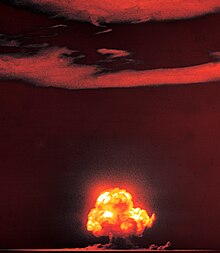Portal:Physics
The Physics Portal


Physics is the scientific study of matter, its fundamental constituents, its motion and behavior through space and time, and the related entities of energy and force. Physics is one of the most fundamental scientific disciplines. A scientist who specializes in the field of physics is called a physicist.
Physics is one of the oldest academic disciplines. Over much of the past two millennia, physics, chemistry, biology, and certain branches of mathematics were a part of natural philosophy, but during the Scientific Revolution in the 17th century, these natural sciences branched into separate research endeavors. Physics intersects with many interdisciplinary areas of research, such as biophysics and quantum chemistry, and the boundaries of physics are not rigidly defined. New ideas in physics often explain the fundamental mechanisms studied by other sciences and suggest new avenues of research in these and other academic disciplines such as mathematics and philosophy.
Advances in physics often enable new technologies. For example, advances in the understanding of electromagnetism, solid-state physics, and nuclear physics led directly to the development of technologies that have transformed modern society, such as television, computers, domestic appliances, and nuclear weapons; advances in thermodynamics led to the development of industrialization; and advances in mechanics inspired the development of calculus. (Full article...)

Trinity was the code name of the first detonation of a nuclear weapon, conducted by the United States Army at 5:29 a.m. MWT (11:29:21 GMT) on July 16, 1945, as part of the Manhattan Project. The test was of an implosion-design plutonium bomb, nicknamed "The Gadget", of the same design as the Fat Man bomb later detonated over Nagasaki, Japan, on August 9, 1945. Concerns about whether the complex Fat Man design would work led to a decision to conduct the first nuclear test. The code name "Trinity" was assigned by J. Robert Oppenheimer, the director of the Los Alamos Laboratory, possibly inspired by the poetry of John Donne.
The test, both planned and directed by Kenneth Bainbridge, was conducted in the Jornada del Muerto desert about 35 miles (56 km) southeast of Socorro, New Mexico, on what was the Alamogordo Bombing and Gunnery Range (renamed the White Sands Proving Ground just before the test). The only structures originally in the immediate vicinity were the McDonald Ranch House and its ancillary buildings, which scientists used as a laboratory for testing bomb components. Fears of a fizzle prompted construction of "Jumbo", a steel containment vessel that could contain the plutonium, allowing it to be recovered; but ultimately Jumbo was not used in the test. On May 7, 1945, a rehearsal was conducted, during which 108 short tons (98 t) of high explosive spiked with radioactive isotopes was detonated. (Full article...)
Did you know -

- ... that Femto satellites are the smallest types of satellites, and the Kalam SAT is one of the smallest Femto satellite ever made?
Selected image -

A ferrofluid is a liquid which becomes strongly polarised in the presence of a magnetic field. Ferrofluids are composed of nanoscale ferromagnetic particles suspended in a carrier fluid, usually an organic solvent or water. The ferromagnetic nano-particles are coated with a surfactant to prevent their agglomeration (due to van der Waals and magnetic forces). Although the name may suggest otherwise, ferrofluids do not display ferromagnetism, since they do not retain magnetisation in the absence of an externally applied field. In fact, ferrofluids display paramagnetism, and are often referred as being "superparamagnetic" due to their large magnetic susceptibility. True ferromagnetic fluids are difficult to create at present.
Related portals
December anniversaries
- 1610 – Galileo Galilei observes phases of Venus.
- 1900 - The peer reviewed journal "Nature" reports on Duddell's "Singing Arc" American Physical Society.
- 1942 - First self-sustained nuclear chain reaction at the University of Chicago under the supervision of Enrico Fermi. American Physical Society
- 1968 – Apollo 8 Launched
- 1995 – Hubble Deep Field images taken.
Births
- 1852 - Henri Becquerel
- 1900 - George Eugene Uhlenbeck
- 25 December, 1642 - Isaac Newton
- 5 December, 1901 - Werner Heisenberg
- 18 December, 1856 - J. J. Thomson
General images
Categories

Fundamentals: Concepts in physics | Constants | Physical quantities | Units of measure | Mass | Length | Time | Space | Energy | Matter | Force | Gravity | Electricity | Magnetism | Waves
Basic physics: Mechanics | Electromagnetism | Statistical mechanics | Thermodynamics | Quantum mechanics | Theory of relativity | Optics | Acoustics
Specific fields: Acoustics | Astrophysics | Atomic physics | Molecular physics | Optical physics | Computational physics | Condensed matter physics | Nuclear physics | Particle physics | Plasma physics
Tools: Detectors | Interferometry | Measurement | Radiometry | Spectroscopy | Transducers
Background: Physicists | History of physics | Philosophy of physics | Physics education | Physics journals | Physics organizations
Other: Physics in fiction | Physics lists | Physics software | Physics stubs
Physics topics
Classical physics traditionally includes the fields of mechanics, optics, electricity, magnetism, acoustics and thermodynamics. The term Modern physics is normally used for fields which rely heavily on quantum theory, including quantum mechanics, atomic physics, nuclear physics, particle physics and condensed matter physics. General and special relativity are usually considered to be part of modern physics as well.
More recognized content
Associated Wikimedia
The following Wikimedia Foundation sister projects provide more on this subject:
-
Commons
Free media repository -
Wikibooks
Free textbooks and manuals -
Wikidata
Free knowledge base -
Wikinews
Free-content news -
Wikiquote
Collection of quotations -
Wikisource
Free-content library -
Wikiversity
Free learning tools -
Wikivoyage
Free travel guide -
Wiktionary
Dictionary and thesaurus
Sources
Portals on Wikipedia
















































































